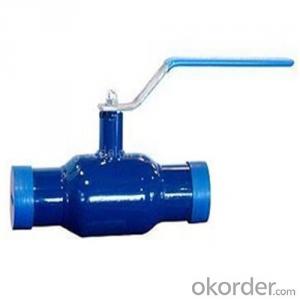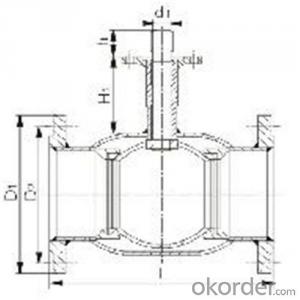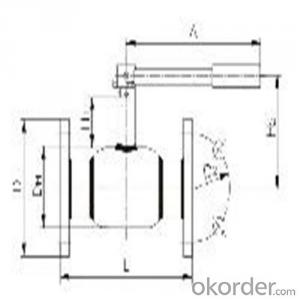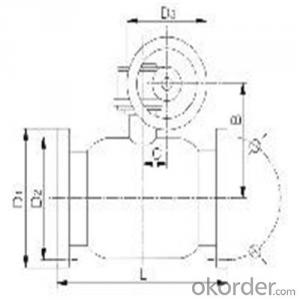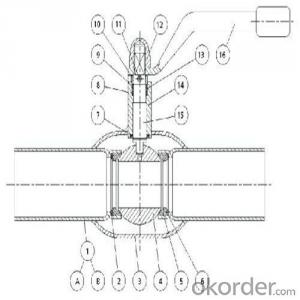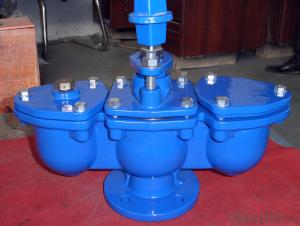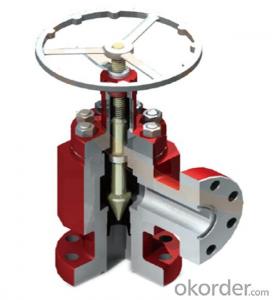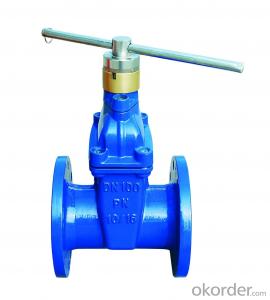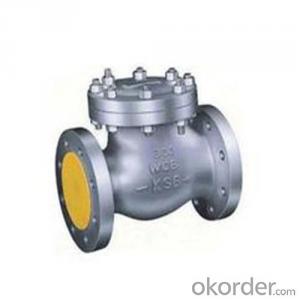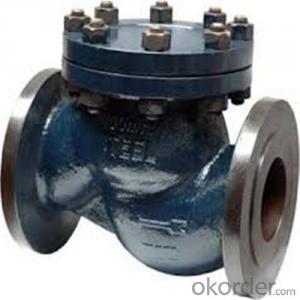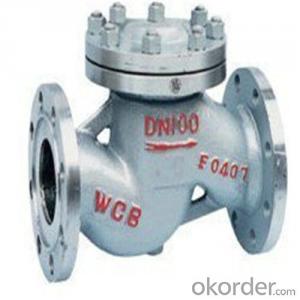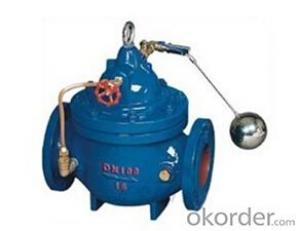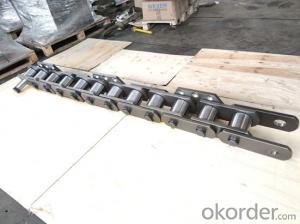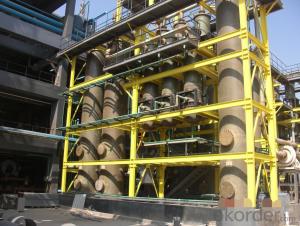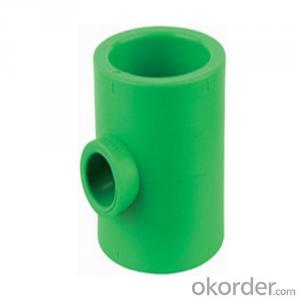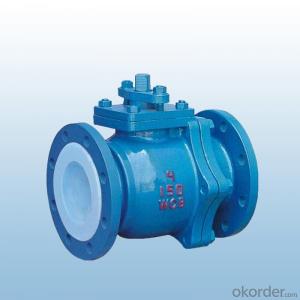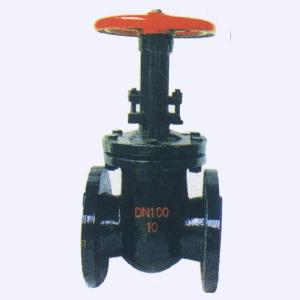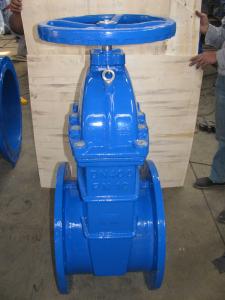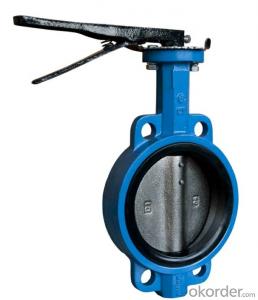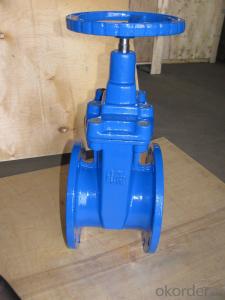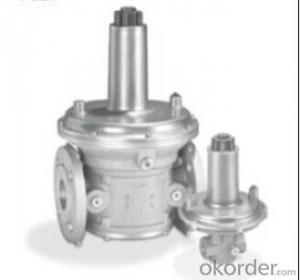Ball Valve For Heating SupplyDN 80 mm high-performance
- Loading Port:
- Shanghai
- Payment Terms:
- TT OR LC
- Min Order Qty:
- 100 pc
- Supply Capability:
- 1000 pc/month
OKorder Service Pledge
OKorder Financial Service
You Might Also Like
Ball Valve For Heating Supply
Product Description of Ball valve for heating supply:
Technical introduction
★The ball valve is designed as fully welded structure,which can prevent the leakage of medium.
★The valve seat is floating and spring-loade.The seal is made of soft seal materials of PTFE+20%C and Viton B.The seat is tightly abutted against the ball surface by the pressure of a spring,so that even if the media is in low pressure,a reliable sealing can be assured for the ball valve.Double piston effect and double seal(two-seal seat)are adopted in specially designed valve seat to realize double sealing,which makes the tightness of the ball valve more advantageous and the operation easier.
★A floating ball is adopted for DN15-DN200,and a stem and trunnion ball is adopted for DN200 and above,which can ensure the accurate position of different size ball.In other words,the sealing performance,low torque valve and operability can be guaranteed.
★The sealing of the stem is fulfilled by two replaceable O-rings and packing consisting of PTEE+20%C or flexible graphite,as the packing seal material,is fire proof effect,and is specially suitable for fuel gas systems.
★The materials used for the valve body and pipelines are the same(carbon steel or SS steel),valve body and stem adopt SS steel and the packing adopts PTEE+20%C which is corrosion-resistance or flexible graphite.
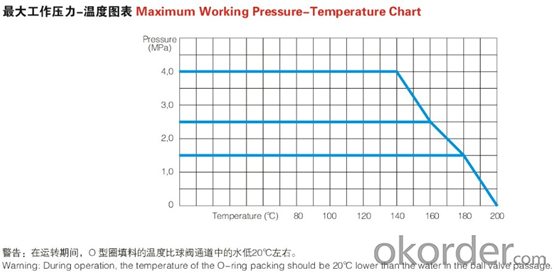
Design Features of Ball valve for heating supply:
Features and Applications
Raymond's fully welded ball valve for heating supplyand Fuel Gas systemare used to control the flow at fully open or closed position,not regulate the flow.Only special types of ball valves can realize the flow regulation.Therefore,our welded ball valves can satisfy the requirements of heating systems,e.g:
★Main pipelines of heating equipment
★Cross channels of heating pipes
★Heat exchanger station and any long distance operating station,e.g:
For the transmission of hot water and two kinds of mixed media(water,air or natural gas),limited to Max.4.0MPa and 200°C.
For the transmission of natural gas and one medium,from -30°C to 60°C,and even up to 150°C using specially designed ball valves.
★Coal gas pipelines,trunk and the branch supply lines.
Standard of Ball valve for heating supply:
Actuator | Gear Handwheel customize |
Connection | Flange SW Weld customize |
Medium | Gas Natural gas Water customize |
Medium Temperature | <200< span="">℃ customize |
Application Fields | Electricity Medical Petrochemical customize |
Connection Standard | EN 1092-1 EN 12627 ISO 7-1 customize |
FAQ of Ball valve for heating supply:
Q1:I can’t find the type of steel check valve which I need. what can I do?
The chart above only lists out some common composition of steel check valve parts.We may provide other different parts material composition according to the customer's request or the actual valve working condition.
Q2:Which certification do your products pass?
Our products are in accordance with ISO 9001、ISO 14001、API 6A、API 6D、TS CE、API607/6FA/BS6755.
Q3:How can I place an order?
The only one thing you should do is to tell us the sepecification about type 、quantity and mode of transportation, then we will send you quotation within 24 hours.
- Q:The valve on my mountain bike tire has a leak, so I want to go buy a new valve (and maybe a couple spares)... how much is the average cost?Thanks!
- It depends on whether you have a presta or schraeder valve. If a schraeder valve, you can buy a bag of them with a remover from an auto parts store for about $3.00 or so. If a presta valve, most of those cannot be replaced so it is new tube time. Are you sure it is a valve? Many times a puncture in the tube will leak through the valve hole AROUND the valve making it seem like a valve.
- Q:I gotta 89 Crx si. Just wondering if you could put on a blow off valve and it work without it boosted
- you can put one on but it wont work.... BUT if you want the whole turb whistle sound you can buy one of those turbo whistles you can put it on the end of your exhuast and it will make that turbo sound but no BOV
- Q:My furnace cut out about a year ago. The hvac guy i used told me the gas valve was no good and that the flu was partially blocked. I cleaned out the flu, he replaced the gas valve ($700+) and it worked great for a year. Today the furnace does not fire up. Pilot is working. I cleaned out the flu (there was definitely quite a bit of debris, so that was probably the cause for the shut off) .... The flu is now clear, but when i turn the system back on the thermostat calls for heat, but there is no gas flow to the burner... could the valve have failed that quick, or should i be looking at something else like the CO sensor or something... just looking for some direction before shelling out another 700 bucks... Thanks in advance for any ideas or assistance....
- I was wondering why the flue is clogged? I've never had to clean mine. Well anyway, I use a shop vac to vacuum out any dust or rust that accumulates on the gas valve on the rare occasions it failed to work,and that fixed it every time.
- Q:I have a 97 ranger 4.0L that takes 10w-30 and I'm going to be changing the oil soon. It has some valve clatter I'm just wondering if I can use a thicker oil such as 15w-30 or maybe a 10w40?
- Valves don't clatter. Sticking or collapsed hydraulic valve lifter do. The use of the normal viscosity 5W-30 full synthetic oil contains a heavy dose of detergents. If gum, varnish or sludge is an issue, repeated use it may quiet things down. This is the least expensive thing to try first. If that doesn't do the trick it's time to (easily) replace the sticking hydraulic valve lifters. Thicker molasses oil may insulate noise while it's cold and heavy but it will never fix the issue.
- Q:the ac replacement valve seems to be leaking i was wondering what is the average cost of having it replaced..
- The valve itself is only a couple dollars. Some shops have a tool that will let them replace a valve without dumping the charge but since its likely low you will likely also have to pay the regular AC service fee which is usually $50-100 plus parts and refrigerant.
- Q:i have a 98 ford escort SE. oil spils out the dipstick. we think its the pressure release valve. sadly we dont know where that is. any imput would be great
- as they said, pcv valve. What you're describing is on a turbo- pressure exhaust valve.
- Q:What is the best procedure to check/adjust valve clearances? This engine is a perkins diesel inside of a cat generator. I know that he exhaust valve is .018 and the intake valve is .008.
- Adam S, you're both right and wrong as far as needing to adjust valves. I changed 2 shims in 100,000 miles on my Kawasaki KZ1000, but my 1300 Kaw touring bike with nearly identical valve train needs checking and adjuuting every 6,000 miles or so. Go figure. Kneedragger, since your bike requires manual adjustment, you're valve train is either going to have a rockerarm type system with threaded screws and locknuts (easy) or use shims of various thicknesses to adjust the clearance (harder). Some have the shim on top of the 'bucket that covers the valve spring. With these, you will need a small, rather inexpensive tool specifically made for your model engine to compress the spring, allowing you to remove the shim. Other engines have the shim under the bucket, requiring you to remove the camshaft to change the shim. No special tools needed here, but reinstalling the camshafts correctly is absolutely vital. While this proceduere sounds rather intimidating, just remember that checking is all that may be necessary and no adjustments will need to be made. To check clearances, the idea is to turn the camshaft to that the cam lobe is pointing away from the valve and then measure the clearance with a feeler gauge and see how that compares to the recommended clearances. On shim type, clearances nearly always tighten and if the clearance is too little, you will need to install a thinner shim. I write down the clearance for each valve each time I check the clearances. If one valve tightens up faster than the others, this will give you a heads up to a possible future problem. Or, you may find they are ok this time but at the next check, you find some that need adjustment and will decide to take it to the shop that time. After a few checks and recording the clearances, you'll get a pretty good feel for how often you need to check them again. If you decide to do it yourself, by all means, get a shop manual.
- Q:One of my valves leaks a small amount of water through the valve and into the water line. why would it leak and what do i have to do to fix it. the valve is a rain jet valve. i would like to fix it without having to remove it from the valve box. inside the valve box there are 8 valves and they are glued in and i dont want to have to remove all of the valves and box.
- Sounds okorder ), and so sometimes its almost easier to replace the whole thing. The rain jet valves definitely aren't the best quality either, so if I were you I'd get a better one just to make sure it is going to work for a long time.
- Q:The valve on my radiator has numbers on it to determine the amount of air/steam leaving the heating system. what number should i put it on and how would i determine it
- I would think the easiest way would be to put a thermometer on the radiator (with the bulb in the air flow), turn the heat on to one setting and record the temperatures each half hour for about 4 hours. Then, turn the adjustment to a higher (or lower) number and repeat that. That way, you'd know which way to turn to set it. Of course, the level at which you'd be comfortable would be found by trying different settings. Assuming the adustment is a valve, valves in the USA will open by turning counter-clockwise. Closing is, of course, clockwise. Hope that helps. EDIT: I received your email - I don't mind at all! OK, so you have only one valve for all the radiators. Without knowing anything else, I'd say you just removed the part called the bonnet (the upper half of a valve). It shouldn't matter which number it's set on if it's reinstalled correctly. When a valve is removed, the best way to put back is to open it slightly (turn counterclockwise to a low number), then reinstall the bonnet. Once it's back in, it should work like normal. If that doesn't work, perhaps you can get a plumber or a local handyman to check it. As to the upper ones being airlocked, it really sounds like there is a blockage in the supply line. I am assuming this is steam-heat radiator that is supplied by a boiler-type heating unit?
- Q:The water in my tub/shower stopped working. I did my research on the net to discover the cause and I also went to Home Depot explained the problem. The worker at home depot helped me get the right part I needed to replace the valve stem. I came home, took the faucet handle off and can see what I need to do next. Everything seems perfect and ready to go, except I can't remove the old valve stem. It seems like the old one should just slide out and the new one replaces it. How do I get the old one out without damaging any of the pipes or hurting myself.
- Do you have a valve for the hot and one for the cold, or does one valve control both? If there are two valves they should just unscrew. You might need to go back to Home Depot and get a wrench designed for valve stem removal. (Before you go, spray it with penetrating oil such as WD-40 and let it do it's thing while you're gone. If it's just one valve for both, there's probably a collar that screws on and holds the cartridge in place. After that is off, the cartridge should slide out-ususally with a little 'persuasion' from some pliers. (But don't try to twist it) Hope you get it.
1. Manufacturer Overview |
|
|---|---|
| Location | |
| Year Established | |
| Annual Output Value | |
| Main Markets | |
| Company Certifications | |
2. Manufacturer Certificates |
|
|---|---|
| a) Certification Name | |
| Range | |
| Reference | |
| Validity Period | |
3. Manufacturer Capability |
|
|---|---|
| a)Trade Capacity | |
| Nearest Port | |
| Export Percentage | |
| No.of Employees in Trade Department | |
| Language Spoken: | |
| b)Factory Information | |
| Factory Size: | |
| No. of Production Lines | |
| Contract Manufacturing | |
| Product Price Range | |
Send your message to us
Ball Valve For Heating SupplyDN 80 mm high-performance
- Loading Port:
- Shanghai
- Payment Terms:
- TT OR LC
- Min Order Qty:
- 100 pc
- Supply Capability:
- 1000 pc/month
OKorder Service Pledge
OKorder Financial Service
Similar products
New products
Hot products
Related keywords
